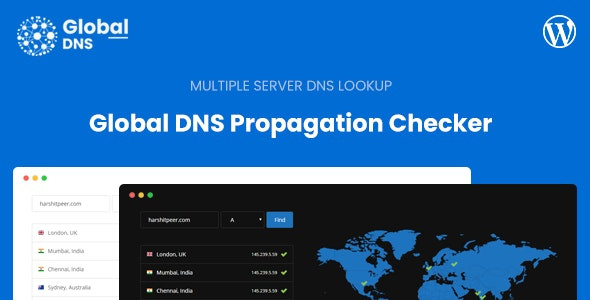Global DNS 2.4

70+ Reviews
with 5 star Ratings

99% Customer
Satisfaction

7-Days
Money Back
Request update for this product.
$99.00 Original price was: $99.00.$2.99Current price is: $2.99.
- Version: 2.4
- Last Updated: 02/10/2024
- License: GPL
- 1 year of updates & unlimited domain usage
- Updates Will Come With A 24-48h Delay
- Original product with the lowest price ever
- Downloaded from original authors
- Instant delivery & fast downloading speed
- 100% clean and tested code
- Get this Product for Free in Membership
The Domain Name System (DNS) is a cornerstone of internet infrastructure, responsible for translating human-readable domain names like “www.example.com” into IP addresses that computers use to communicate with one another. The concept of Global DNS refers to the worldwide network of servers and systems that make DNS possible on an international scale, ensuring smooth and efficient access to websites and online services from any corner of the globe. In this article, we’ll explore what Global DNS is, how it functions, its benefits, challenges, and its role in the modern internet.
What is DNS?
Before diving into Global DNS, it’s essential to understand DNS itself. DNS works like a phonebook for the internet, converting domain names into IP addresses. When you type a website’s URL into your browser, your device sends a request to a DNS server to look up the IP address associated with that domain. The DNS server responds with the appropriate IP address, enabling your browser to load the website.
Global DNS Overview
Global DNS takes this fundamental DNS process and scales it to ensure that the internet functions seamlessly on a worldwide level. The global network of DNS servers is distributed strategically across the planet, ensuring that DNS lookups are quick, reliable, and available no matter where a user is located. This network includes various types of DNS servers such as root servers, authoritative servers, and recursive resolvers, all working together to ensure the correct resolution of domain names.
How Global DNS Works
Global DNS is built on a hierarchical model consisting of several layers of servers:
1. Root Name Servers
At the top of the DNS hierarchy are root name servers. There are 13 sets of root servers worldwide, which handle requests for the top-level domains (TLDs) like .com, .org, .net, and country-specific TLDs like .uk or .jp. When a DNS request is made, if the local server doesn’t know the answer, it queries one of these root servers to direct the request to the appropriate TLD.
2. Top-Level Domain (TLD) Servers
Once the root server points to the TLD, the TLD server takes over. For example, if you’re trying to access “www.example.com,” the root server directs the query to the .com TLD server. These servers manage the specific domains under their TLD, guiding queries to the authoritative DNS server for the requested domain.
3. Authoritative DNS Servers
Authoritative DNS servers hold the actual DNS records for a domain. These servers provide the final IP address that allows users to connect to the website or service. For “www.example.com,” the authoritative server will deliver the specific IP address for the website.
4. Recursive DNS Resolvers
These servers act as intermediaries between your device and the other DNS servers. When you enter a URL, your device queries a recursive resolver, which then queries other DNS servers as needed. The recursive resolver caches responses to speed up future requests.
Benefits of Global DNS
The global distribution of DNS servers provides several advantages for users, website owners, and businesses:
1. Improved Speed and Performance
Global DNS ensures that users are connected to the nearest DNS server, reducing the time it takes to resolve domain names and load websites. This is known as latency reduction, which improves the overall user experience. By having DNS servers distributed across multiple locations, content is delivered faster, which is particularly important for global audiences.
2. High Availability and Reliability
Global DNS provides redundancy by having multiple servers in different regions handle DNS queries. If one server goes down, others can take over, ensuring continuous availability. This redundancy is essential for preventing DNS-based outages that could make websites inaccessible.
3. Scalability
The Global DNS system is highly scalable, capable of handling billions of DNS queries each day. As the internet continues to grow, more servers can be added to meet the increasing demand. This scalability ensures that the DNS infrastructure keeps up with the expansion of the online world.
4. Geographical Optimization
By routing DNS requests to the nearest server, Global DNS helps reduce load times based on user location. This geographic optimization not only improves speed but also ensures that regional regulations or restrictions are adhered to, such as complying with data localization laws.
5. Load Balancing
Global DNS can distribute traffic evenly across multiple servers, reducing the risk of any single server becoming overwhelmed with too many requests. This load balancing is particularly crucial for high-traffic websites and services like streaming platforms, e-commerce sites, and online gaming.
Challenges of Global DNS
While Global DNS brings many benefits, it also comes with several challenges that need to be managed:
1. Security Threats
DNS is a frequent target for cyberattacks, such as DNS spoofing (where attackers trick users into visiting malicious sites) or DDoS (Distributed Denial of Service) attacks aimed at overwhelming DNS servers with traffic. These threats can undermine the reliability of Global DNS and create widespread disruptions.
To counteract these attacks, protocols like DNSSEC (Domain Name System Security Extensions) have been introduced. DNSSEC adds an additional layer of security by verifying the authenticity of DNS records, ensuring that users aren’t redirected to fraudulent websites.
2. Privacy Concerns
DNS queries can expose user activity to third parties, including Internet Service Providers (ISPs) or malicious actors, leading to privacy concerns. Unencrypted DNS requests can be intercepted, revealing the websites users are attempting to access.
To address this, modern approaches like DNS over HTTPS (DoH) and DNS over TLS (DoT) have been developed. These protocols encrypt DNS requests, protecting user privacy by preventing third parties from snooping on DNS traffic.
3. Propagation Delays
When changes are made to DNS records (such as changing a website’s IP address), it can take time for these changes to propagate across the global DNS network. This delay, known as DNS propagation, can last anywhere from a few minutes to 48 hours. During this time, users may be directed to the old IP address, causing inconsistencies in accessing the updated site.
Global DNS in the Future
As the internet continues to evolve, the importance of Global DNS will only grow. Several trends and innovations are shaping the future of this system:
1. Edge Computing and DNS
Edge computing aims to bring processing closer to the user, reducing latency. DNS is a critical part of this process, as it ensures that users are connected to the nearest servers, allowing for faster content delivery. As edge computing becomes more widespread, Global DNS will play a central role in optimizing these networks.
2. 5G and IoT
The rollout of 5G and the proliferation of the Internet of Things (IoT) will lead to a dramatic increase in the number of connected devices. This growth will put additional strain on the DNS infrastructure, requiring Global DNS to scale further to handle the massive influx of DNS queries from IoT devices.
3. Improved Security Protocols
As cyber threats evolve, so too must DNS security. Innovations in encryption and authentication, such as improved DNSSEC adoption, will help secure Global DNS against emerging threats, ensuring that DNS queries remain private and secure.
Conclusion
Global DNS is an integral component of the internet, enabling users worldwide to access websites and online services quickly and efficiently. By leveraging a distributed network of servers, Global DNS enhances speed, reliability, and scalability, making it a fundamental part of the modern web. However, challenges like security threats, privacy concerns, and propagation delays need to be continually addressed to maintain the system’s integrity.
As new technologies such as 5G, IoT, and edge computing emerge, Global DNS will continue to evolve, providing the backbone for an ever-growing and increasingly interconnected world.
You must be logged in to post a review.




Reviews
Clear filtersThere are no reviews yet.